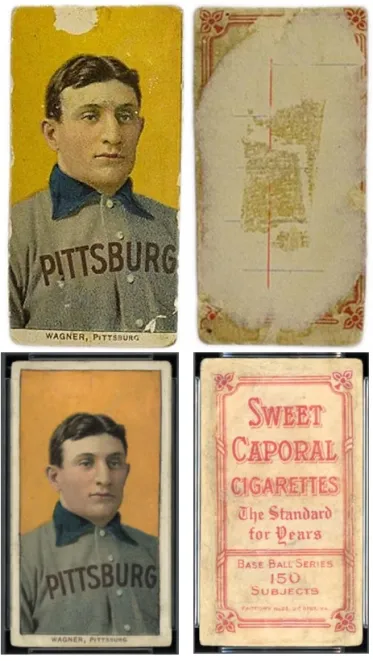PSA and Kurt’s: What Happened?
It is “breaking news” on various outlets that PSA recently made the bold move to decertify cards after learning that, prior to submission, they had been “cleaned” or otherwise “treated” by Kurt of Kurt’s Card Care.
I have found the reporting on this incident to be lackluster, and Kurt’s responses to date have not been especially useful or coherent. This being the case I will not link to the stories. You can Google the details if desired but in short, PSA had graded these cards; later learned of Kurt’s handling of the cards which they declared “alterations” though which were not detected at the time of grading; and as a result, decertified the numbers, essentially rendering the cards raw / ungraded / altered.
First, let me be clear that this article is not about Kurt or his products, as I have no first-hand knowledge of either. I will mention that I have no idea what is in Kurt’s concoction and no ingredients are listed. Personally, I would never put any unknown chemical in contact with my cards. I have spent the last couple of years studying paper, art conservation, and restoration, and various adhesives. I don’t consider myself an expert–just an informed enthusiast. My personal approach is to only use methods that would be appropriate in a conservation setting. More on restoration in a bit however.
As a Cuban card collector who has personally removed hundreds if not thousands of Cuban and American (Topps, Bowman, etc.) cards from albums, removed glue and scrapbook debris, and has submitted hundreds of such cards for grading, I do have some thoughts. And for the record, I have never had a single card returned from SGC as “Altered” after any such removal. Further, there are at least thousands of T206, Cuban, and other cards in PSA slabs that show very clear and obvious evidence of album removal. So, where do we draw the line between acceptable “cleaning” (which receives a numerical grade) and “alteration,” which received only A / Authentic Altered?
So while the Kurt’s story is a launching point, my primary interest in this piece is to explore the apparent gray areas between acceptable practice, alteration, and restoration.
PSA’s History of (Alleged) Alteration Fraud

PSA’s first graded card, the allegedly trimmed Wagner
Let’s not forget that it is alleged that the very first card PSA ever graded, the famed T206 Honus Wagner in a PSA 8, is likely an altered (trimmed) card. Yet PSA has not decertified the card, or even made any serious attempt to address the allegations. There is a thorough, long-documented history of PSA slabbing allegedly-altered (usually trimmed) cards, possibly knowingly. And I have personal knowledge of PSA currently working alongside a suspected card trimmer to “prepare” the collection of a famous and recently deceased collector for grading and then for auction. This at least gives the appearance that with the right connections, altered cards can be graded.
So this begs the question: why now, and why with Kurt? Is it just because he is public about something that is traditionally swept under the rug?
What is Alteration? So Many Questions . . .
Much of this conversation begs the question: what is an alteration? If one uses pantyhose to remove waxy residue from a card front (a very common practice, and undetectable after the fact), is this acceptable, or is it an alteration? Do we consider the wax to be original to the card? By the most strict possible definition, any “change” to a card between manufacture (or pack) and market could be considered an alteration.
A related issue is the “tree in the forest” idea–one would never know if a card was ripped from a pack with wax on it. So who would ever know or care if it was removed? If I posted a video of wax removal, then an “after” of the cleaned card in a PSA slab, would that warrant PSA decertifying the grade? If I’m in charge, the answer in this case is no.
How about the practice of using moisture and pressure to relax a wrinkle out of a card surface? This is something that Kurt has made many videos about, by the way–it’s also not a new practice, nor is it especially difficult. If grading does not catch this practice, is it an alteration? Does it warrant decertification after the fact? For me personally, yes in this case.
And I will guess grading companies look at it pretty much the same way: removal of a foreign body / substance / debris from a card is not an alteration (i.e. wax removal is fine). These are neither original to the card nor are they “in” or part of the card. But once a card is wrinkled or creased, the paper is irreparably compromised–the defect is “in” the card. Though the wrinkle might now be “invisible,” the card was doctored for the purpose of removing a defect that was not part of the manufacturing process of the card.
PSA states that it “will not grade cards that bear evidence of trimming, re-coloring, restoration, or any other forms of tampering, or are of questionable authenticity.” “Tampering” is not defined and presumably intentionally open-ended. Collectors deserve a more exhaustive answer to how the grading companies define “Altered.”
A New Wrinkle: “Restoration”
It might seem obvious to state that some practices are clearly alterations: for example, “adding color” to a card to “improve the appearance” of a chipped border will receive an “A” grade every time. Or will it?
Again, enter PSA and yet a different T206 Wagner, for which they broke out a new designation: “Restored.” This card sold for over a million bucks in 2021.

Before and After of the “Restored” Wagner
What’s Next?
In practice, I’m not sure what prevents someone from simply cracking and resubmitting the decertified cards for grading yet again. PSA owns patents for technology that can take a digital fingerprint of any card they grade. In theory, this would prevent the craze of cracking cards and resubmitting for regrades, since the software would recognize the card as having been previously graded. Whether this is in use currently, I have no idea. Perhaps a reader can fill me in.
It seems to me that most collectors would agree that some forms of card doctoring are clearly alterations: namely, trimming and recoloring chipped borders, for example. And my guess is there would also be consensus that removing wax residue from a card surface is acceptable practice. Between the two extremes, there is just a lot of gray area, and it would benefit the collecting community if the grading giants collaborated on a common definition of Alteration otherwise.
If you’re interested in more conversation on this, please comment below or consider joining Cardhound and hanging out with us in the forums!





Why is restoring or altering cards such a heinous, mortal sin almost akin to murder; but for other collectibles like comic books, vintage cars, movie posters ,etc. it is perfectly acceptable and actually enhances the value and beauty of the item?
This is a great question. There is no great answer, but maybe part of it is that in cards, “altering” has almost always been done with the intent to deceive or defraud. In some parts of the art world, restoration has been more normalized–and even desirable in many cases since often the resto work also preserves and enhances the piece.